Using Novell Net Publisher to Publish, Share, and Store Files on the Web
Articles and Tips: article
Technical Editor
DeveloperNet University
mmckell@novell.com
01 Sep 2000
This AppNote examines the business needs associated with Web publishing and establishes criteria for an effective Web publishing solution that meets enterprise needs for ease of use, manageability, and security. It then introduces Novell Net Publisher 2.0 and shows how this innovative solution addresses the problems associated with traditional Web publishing tools.
This article is adapted from the Novell Net Publisher White Paper and other documents available at http://www.novell.com/products/netpublisher.
- Introduction
- Why Users Need an Integrated Web Publishing Solution
- Novell Net Publisher--The Web Publishing Solution
- Net Publisher Architecture
- Functional Overview
- Beyond Publishing
- Installing Novell Net Publisher
- Conclusion
Introduction
The Internet and its associated technologies provide a far-reaching and economical means of disseminating essential business documents and fostering collaboration among employees, customers, and business partners. However, publishing business documents on internal and external Web sites, and keeping them up-to-date is a cumbersome and complicated process that typically involves the use of a multitude of Web publishing tools and the help of technical support staff. As a result, the business people, who are directly involved with the creation of documents, turn them over to the support staff for publishing, management, and update. This introduces delays and more work for all involved.
Companies need a way to put document creators in control of document publishing, enabling them to post documents to the Web quickly and effortlessly. They also need to control access to those documents and have the flexibility to update the content when required. At the same time, companies need to keep Web administrators in control of the site itself to maintain overall site integrity and security.
Why Users Need an Integrated Web Publishing Solution
In today's e-business environment, speed and agility are critical to business success. Companies need to communicate and share information among employees, customers, and business partners faster and easier. The immergence of the Internet, intranets, and extranets--a one net environment--provides the ideal medium for communicating and sharing a wide variety of business documents. Traditionally, these documents have been distributed in hard copy, which is costly and time consuming, in both initial publication and continued maintenance. The business benefits of moving these processes are compelling. For example, companies can:
Increase the speed of publishing documents in human resources, procurement, training, and other areas to ensure that people always have up-to-date information. At the same time, they can dramatically reduce printing and distribution costs.
Strengthen business relationships and reduce the cost of doing business by disseminating information to business partners over extranets.
Augment e-commerce systems with product catalogs, marketing collateral, and other documents on Web sites, extending their reach to new markets and enhancing their ability to take advantage of new business opportunities.
Enhance collaboration among employees and business partners by facilitating the co-creation of business documents.
Imagine, for example, how much more quickly a company could put together a launch plan for a new product using Web-based document collaboration. The product manager takes responsibility for creating and publishing the document on a secure Web site. The manager then grants access rights to people on the product launch team, enabling them to access and update the document as deemed appropriate. Internal marketing communications specialists, product experts, and financial managers all contribute to the plan, based on their area of responsibility and expertise. External consultants, advertising and public relations representatives incorporate ad strategies, PR campaigns, trade show information, and other details. Everyone can access the document using a Web browser or the document's native application.
The problem companies face, however, is that the current generation of Web publishing tools makes it difficult and time consuming to publish documents on Web sites and keep them up-to-date. Today's tools are complicated and cumbersome. Users must employ a number of different tools to create and publish a document. As a result, the business people who own the documents typically turn them over to a Web master or administrator for Web publication, update, and management--that is, to someone who has the technical expertise to use the tools. This process takes time and introduces delays, which slow down business processes.
The challenge is to put business people back in control of Web document content without jeopardizing the security and integrity of the Web site. The solution is to empower business people to create, post, update, and manage their own documents. At the same time, companies need to keep the IT staff in control of the Web site itself, taking responsibility of issues such as site integrity and security, site structure, link management, site appearance, and standard document formats.
To meet this challenge, companies need a new, integrated Web publishing solution that simplifies and streamlines the publishing process without sacrificing security and control.
Requirements for a Solution
To overcome the shortcomings of traditional solutions, the new Web publishing solution must meet a number of demanding requirements ranging from ease of use/management, integration, access control, approval routing, support for native application file formats, and the ability to fit into existing network infrastructures.
Ease of Use. An effective Web publishing system should make it easy for business people to create, publish, and update documents on the Web without technical knowledge, and without having to learn and use specialized tools. This ensures that anyone who can create a document can publish it. It also significantly reduces training and support requirements.
Integration. Document owners should not have to wade through a collection of disparate tools to create and publish a document. Instead, the publishing tools should be integrated and present a seamless, unified solution to the document owner.
Security and Access Control. Because many documents contain confidential or sensitive information, the ability to protect them from unauthorized access is essential. Today's Web servers provide site-level security to ensure that only authorized users can get into certain sites, such as HR sites that contain employee information. In addition, administrators can further restrict access to certain areas within the site. For example, any user may be permitted to enter an area of the site that contains company and product information; however, only authorized sales people, would be permitted to enter the area containing sales and competitive information.
The Web publishing solution should provide additional access control over that of the Web server, at two hierarchical levels:
Shared working area level. The administrator should be able to reserve protected working areas within the site, where authorized people can place and share documents that are "in process." These include drafts of documents that are being co-developed for publication or completed documents that are moving through an approval process prior to publication.
Document level. Within the shared working areas, document owners should be able to restrict access further to the documents they own, granting various access privilege levels only to certain users or user groups. Owners, for example, should be able control who can view and/or update their documents within the shared working area. In the launch plan example presented earlier, the product manager could grant certain users the right to view only, while granting others the right to view and modify the launch document.
Easy, Centralized Management. The rapid growth and tremendous volume of documents being published to the Internet and intranets makes management an important consideration in selecting a Web publishing solution. The Web publishing solution should allow centralized management--including security and access control. The IT staff should be able to manage the Web publishing solution from a central location and users should also be able to manage their documents from a central location.
Centralized management suggests that the solution should be directory-enabled. Only through a directory can a Web publishing solution provide centralized management of document security and of the document management tools the administrator needs to ensure efficiency, performance, and security of the site.
The solution should leverage current site management tools and site search tools. An additional desirable capability is to allow Web administrators to establish document templates. These templates allow Web administrators to ensure standardization in the look-and-feel of documents, and they simplify document creation and formatting for authors.
Approval Routing. The basic purpose of a Web site is to make information widely available, both internally and externally. Therefore, it is essential to ensure that proper approvals are obtained before Web documents are published. A Web publishing solution should facilitate the approval process, automating it where possible, such as by routing documents to the appropriate people in an organization and requiring approval prior to publication. This routing and approval functionality augments Web publishing capabilities and ensures the accuracy and appropriateness of critical business information.
Support for Native Document Formats. A major shortcoming in current Web publishing technology is that Web documents cannot be manipulated in their native application format. Once they are created in the native application, they must be converted to Web format, usually HTML. Any required updates must be made to the original file (in the native application) and converted again to HTML--so document authors typically maintain documents in both native and HTML formats. In some cases, the native application file may no longer be available. If that occurs, the document owner may have to go through cumbersome steps to transfer the information from the HTML file to the original application for editing and then reconverting the document to HTML for publishing.
To increase efficiency and to eliminate the extra steps and delays introduced by format conversion, the solution should enable document owners to create and maintain all documents in native document formats--regardless of type. Conversion should be automatic and dynamic.
Integration with Current Infrastructure. Most organizations have standardized on document creation tools. Most business users are already familiar with the company-standard word processor, spreadsheet, presentation package, and other tools. Some business users and many technical people are also familiar with HTML editors and Web publishing tools used by their company. The new Web publishing solution needs to integrate with the tools people already know and use and not require business users and technical staff to learn new ones.
Microsoft Office is one of the most widely used document creation suites. With the recent release of Microsoft Office2000, it's essential that a Web publishing solution not only integrate with Office2000 but also leverage its Web features. Furthermore, the solution should support evolving industry standards for file usage on the Internet, standards such as Web Distributed Authoring and Versioning (WebDAV).
Novell Net Publisher--The Web Publishing Solution
Novell Net Publisher 2.0 is a cross-platform Web publishing solution that allows business users to regain control of the creation, management, and publication of their Web content. Novell Net Publisher is designed to run in today's heterogeneous networks and supports NetWare and Microsoft Windows NT. It also supports Microsoft Office2000, and augments the Office2000 Web publishing capabilities with important additional features such as searching, automated approval cycling, and tight security.
Novell Net Publisher 2.0 makes Web publishing as easy as storing and updating documents in a folder on a local or network drive. In addition, it permits document owners to control access to their documents. With Net Publisher, any business user can utilize the Web as a virtual storage medium for their business documents.
Net Publisher enhances collaboration by facilitating the co-creation of business documents. To streamline the process of document co-creation, Net Publisher provides a number of document management features, including approval routing and document check-in/check-out.
Directory-Enabled for Centralized Management
Novell Net Publisher is a directory-enabled Web publishing solution. It is integrated with Novell Directory Services (NDS) eDirectory using the industry-standard Lightweight Directory Access Protocol (LDAP). Because it is directory-enabled, Net Publisher offers the centralized security and management businesses need to control Web publishing without driving up network management and administration costs. Through NDS eDirectory, the administrator maintains control of the overall Web site, specifying the servers and the areas within each site where documents reside, as well as determining site structure and access rights to various site areas. And just like other NDS eDirectory-enabled services, administrators manage the Net Publisher controls using ConsoleOne.
Flexible Work Areas
The administrator can set up work-in-progress areas on the site--in the form of folders--and restrict access rights to these areas through NDS eDirectory. This means that administrators don't have to set up and maintain separate security databases for work-in-progress areas. Access control to Net Publisher files and folders is handled by Net Publisher allowing it to run identically on any server platform.
Within the work-in-progress areas of the site, document owners can create and share documents with coworkers, business partners, customers, and others. The document owners control access to their documents, enabling them to collaborate with colleagues in a secure manner to co-create documents, and administrators don't have to be involved. Owners can grant access by user or user group and they can control access privilege levels, from view only to full editing and updating.
Easy to Use and Efficient
Net Publisher is designed for nontechnical business people. Anyone who can use a word processor and a Web browser can create and publish business documents on internal and external Web sites. It's as easy as saving them to a folder on a computer. Owners and users of documents work with them using a familiar browser interface, so there are no new tools to learn.
Authors can create and update documents using their favorite application, such as Microsoft Word, without having to worry about document conversion, because Net Publisher can dynamically and automatically convert documents from their native formats to HTML. This does away with cumbersome conversion steps and eliminates the need to maintain multiple copies of documents in different formats.
WebDAV Support
Novell is a leader in the creation and ongoing development of WebDAV, the evolving standard for file usage on the Internet. WebDAV extends the HTTP/1.1 standard to provide additional functionality for accessing files from and returning documents to the Internet. It allows interoperability among WebDAV-compliant clients and servers. Through WebDAV support, Novell Net Publisher ensures that customers have an open platform that is easy to extend and customize.
Cross-platform Solution
Novell Net Publisher 2.0 is a Java-based, cross-platform solution that supports NetWare and Microsoft Windows NT, enabling it to fit into a variety of network environments. In addition, it integrates with Microsoft Office2000, giving companies the flexibility to move to this powerful new system. Net Publisher augments the Web publishing capabilities of Office2000 by adding strong security for critical business information that is stored outside the firewall. This added security is essential when extending access beyond the firewall to remote employees, customers, and business partners.
Net Publisher API
As it is out of the box, Novell Net Publisher 2.0 is a great application for sharing, managing, and publishing files. The real value of Net Publisher, however, is the ease with which it can be customized to meet the specific needs of any organization. Net Publisher has a documented API which allows a programmer to write Java programs that access document stores. The API can perform any action that the standard product can do. In fact, the Net Publisher client is nothing more than a Java servlet that uses the Net Publisher API to manipulate documents in a store. The API makes it easy to write custom utilities that perform business logic specific to the way that an organization is using the product.
The most powerful part of the API is a concept called event listeners. Event listeners are small Java programs which are notified when certain events happen in the Net Publisher system. Typical events which might be monitored by a listener are document adds, moves, copies, and deletes, folder creation, or deletion, user logins, or system errors. An event listener specifies which events it wants to know about and whether it wants to hear about those events before or after they are processed. If the listener catches an event before it is processed then it has the option of overriding Net Publisher's normal response to that event. Regardless of when the event is caught the listener can perform tasks that would not normally be performed. For example, a company might decide that all documents should be backed up before they are deleted. This could be accomplished by writing an event listener that catches delete events before they are processed. The listener would back the file up to tape before allowing Net Publisher to complete the deletion.
There are endless possible ways to use listeners and to customize Net Publisher to meet an organization's needs more closely. For information about the Net Publisher API and for sample code, see the component "Leading Edge 132 - The Net Publisher 2.0 API" on the Novell Developer Kit web site, http://developer.novell.com/ndk/.
Net Publisher Architecture
Novell Net Publisher consists of four main components: the Net Publisher client, the Net Publisher Server, the Net Publisher Store, and the Indexer/Converter (see Figure 1).
Figure 1: The architecture and design of the Net Publisher system.
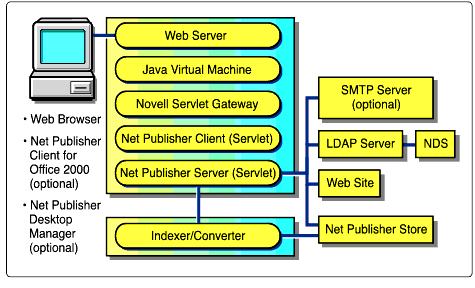
The Net Publisher client and Net Publisher Server are servlets that run on the Web server. The Net Publisher client provides the browser interface that passes user requests to the Net Publisher Server for processing. For example, a request to log in to the Net Publisher Store (the directory structure that contains users' working files) is passed to the Net Publisher Server, which then authenticates the user to NDS through the LDAP server.
The Indexer/Converter indexes files in the Net Publisher Store to provide searching, and converts files to HTML for viewing or publishing. The Indexer/Converter can be run as a NetWare NLM or a Windows executable on a Web server or other server.
The Net Publisher client for Microsoft Office 2000 and the Net Publisher Desktop Manager are optional. The client integrates with Word 2000, Excel 2000, and PowerPoint 2000 to enable users to create files and add them directly to the Net Publisher Store. The Desktop Manager integrates with the desktop's Windows Explorer and My Computer features to enable users to access the Net Publisher Store through Web folders.
Functional Overview
The following sections provide brief overviews of some of Net Publisher's functionality from the user's perspective.
Working with Files
Using the Net Publisher client, users add files to the Net Publisher Store's working files directory structure, see Figure 2. While in the working files directory, users can manipulate files in any folder for which they have appropriate access rights. Files can be shared with other users, checked out for editing in their native format, copied or moved from one directory to another, and converted to HTML.
Figure 2: The Net Publisher Web browser interface showing a view of folders and files.
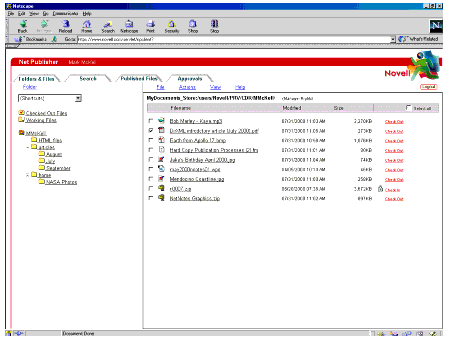
Sharing Folders
During installation, you can configure Net Publisher to give each user a folder in the Store's working files directory structure. A user's folder is his or her personal working space. The user has full access rights (manager rights) to the folder and can share it with other users without requiring administrative assistance. To share a folder with others, users would complete the following steps:
Click the Folders & Files tab.
Click the folder you want to share.
Click the Net Publisher Folder menu and select the Share... option (see Figure 3).
Figure 3: The Folder menu options available within Net Publisher's Web browser interface, by clicking on the Folder "link".
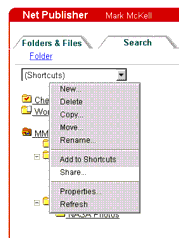
Ensure the Sharing tab is selected.
Deselect the "Use parent folder's settings" box (see Figure 4).
Figure 4: Sharing folders with other Net Publisher users.
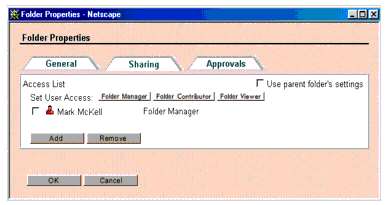
Click the Add button to use the Net Publisher Address Book to select and add user names, then click OK.
Select the box to the left of the user name and click the button to set that user's access level (Folder Manager, Folder Contributor, or Folder Viewer).
Click OK.
The users you have shared the folder with will receive an e-mail notification that the folder has been shared with them, and the location of the shared folder will automatically be added to their Shortcuts list. When they select this shortcut, they can see the shared folder and any subfolders of the folder.
Publishing Files
When a file is ready to be published, the user submits it for publishing. Depending on the approval model established by the folder's user, the file is published (Publish without Approval), the user is notified that files can't be published from that folder (No Publishing Allowed), or the file is routed to one or more predefined approvers for approval or rejection (Publish with Approval).
If a file requires approval, it is placed in the Store's pending files directory structure (a duplicate image of the working files directory structure). Approved files are removed from the pending files directory, converted to HTML if necessary, and copied to the Web site. Once the file is published, the user receives an e-mail reading that the file has been published along with its URL and a history of the approval process, see Figure 5.
Figure 5: Sample e-mail notification after you publish files over the Internet.
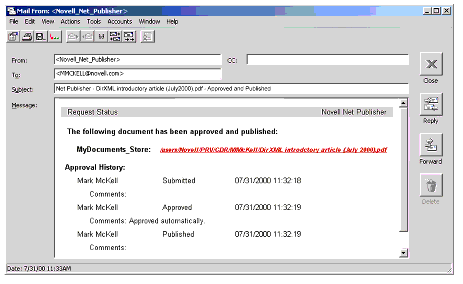
Providing File Security
Net Publisher provides file security through folder-level access rights and file-level access rights. Depending on a user's needs in a folder, the user can be given manager, contributor, or viewer access rights. Net Publisher administrators and folder managers control folder access. Individual file owners control who has rights to edit files. To do so, a user would select the desired file and complete the following steps:
Click the Net Publisher File menu and select Properties.
Ensure the Sharing tab is selected.
Click the Add button to use the Net Publisher Address Book to select and add user names, then click OK.
You can also include additional editors by changing the edit rights as defined by the user's access level (Manager, Contributor, or Viewer). For example, if you initially granted a user only Folder Viewer access to your folder, you can grant that user Contributor rights to that file only by selecting the "Give Folder Viewer editor rights (This includes Folder Contributors)" option, as shown in Figure 6.
Figure 6: Modifying and controlling folder and file access.
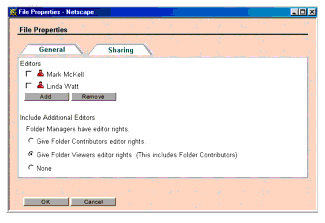
Also of note within the File Properties view is the General tab. The General tab displays important file information about the file (see Figure 7). The file Information portion lists the Filename, a space where you can add a Description of the file, the file Size, Creator's name, File Creation Date, and Status (Available or options to Check In or Cancel Check Out, as well as to whom it is checked out and on what date). The file Publishing portion lists the Approval status (Not pending approval, Pending approval, and No publishing allowed), Published status (Not published or Published, which includes the date it was published and its URL and the option to Unpublish the file), and whether the file will be converted to HTML on preview or publish.
Figure 7: File information and options available from within the file's properties on the General tab.
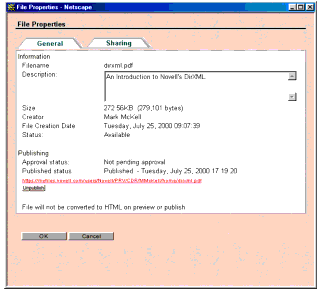
Beyond Publishing
Novell Net Publisher is a great tool for publishing documents over the Internet, but it is also an excellent platform for employee file sharing, document collaboration and management, and personal storage.
Sharing Files
Net Publisher lets users share files with other users at their own discretion, similar to the feature of sharing folders. For example, if employees within different departments who don't share a common directory on the company's network drives and would like to share files with one another, it could be easily done with Net Publisher. To share a file, the user could either grant the other user rights to view or edit a specific file, e-mail the file through Net Publisher, or publish the file and send the URL to the user.
Collaborating and Managing Documents
Flexibility and security are important features in collaborating and managing documents. Net Publisher meets the flexibility requirement by allowing users to access their documents from any computer that is connected to the Internet. This allows users to collaborate on files and manage them from anywhere. However, with so much flexibility comes concerns about security. Net Publisher promises strong security because of its tight integration with NDS eDirectory for authentication. It can be configured with 128-bit encryption keys, 20 character passwords or more, and secure authentication through LDAP and Novell PKI services and Secure Sockets Layering (SSL).
With the convenience and peace of mind that comes with Net Publisher's flexibility and security, users can collaborate and manage their documents from the office, the home office, or the road.
Storing Files
Novell Net Publisher can also be used by employees as an Internet file storage system. While other Internet-based companies offer similar storage services, Net Publisher provides the following advantages:
Default membership. Each employee is granted a Net Publisher folder or account by default, without having to sign up for additional services or commercial agreements.
Single user name and password. Your user name and password are the same as your network login, so you don't have to learn and remember additional ones.
Faster service. There are no banner ads or crowds of users common to commercial sites.
Net Publisher allows employees to upload and download personal files to or from home and office without having to use disks, other media, e-mail, or burdensome commercial sites as transport or storage.
Installing Novell Net Publisher
This section describes the system requirements for installing Novell Net Publisher 2.0, some pre-installation guidelines to preparing and designing your Net Publisher server, and how to access Net Publisher once it's installed.
System Requirements
One of the following Web servers on which to install the Net Publisher files:
Netscape Enterprise Server 3 for NetWare (included on the Novell Net Publisher 2.0 CD) installed on a NetWare 5.x server. NetWare 5.0 requires NetWare 5.0 Support Pack 2 or later. NetWare 4.x is not supported.
Netscape Enterprise Server 3.6 or later for Windows NT.
Microsoft Internet Information Server 4.0 for Windows NT.
JVM 1.1.7b or later and the Novell Servlet Gateway installed on the Web server. The Net Publisher Installation Advisor lets you install JVM 1.1.7b and the Novell Servlet Gateway from the Novell Net Publisher 2.0 CD.
ConsoleOne, version 1.2c.2 or later. The Net Publisher Installation Advisor gives you the option to install ConsoleOne 1.2c.2 from the Novell Net Publisher 2.0 CD.
A Novell LDAP server located in the NDS tree where you will install Net Publisher. The LDAP server must be running on a NetWare 5.x server that has SAS and PKI installed, or on a Windows NT server.
Windows users must have Microsoft Internet Explorer 4.0 (or higher) or Netscape Navigator 4.06 (or higher). Macintosh users must have Microsoft Internet Explorer 4.5 (or higher) or Netscape Navigator 4.51 (or higher).
(Optional) An SMTP server for e-mail notifications (approved and rejected file and folder sharing notices).
(Optional) Microsoft Office 2000 is required for the Net Publisher client for Office 2000. Internet Explorer 5 (Web folders) is required for the Desktop Manager.
Pre-Installation
Before you begin installing Novell Net Publisher, you should complete the following tasks:
Gather the information required for creation of your Net Publisher system.
Verify that you have the file system and NDS access rights required for installation.
Create an NDS user account for the Net Publisher Server.
Configure the LDAP server's security method.
Gather System Information
The Net Publisher System Setup Advisor prompts you for specific setup information, including:
The location on the Web server where you want to create the Net Publisher directory. The Net Publisher Server, Net Publisher Store, and Indexer/Converter files are installed to this directory. The default directory is \\server\volume\NETPUB.
The type of Web server you are using, the location of the Web server's document root directory, and the Web server's IP address (or DNS host name) and port.
The NDS names and contexts for the Net Publisher Server object and Net Publisher Store object. The default names are NetPub_Server and NetPub_Store.
The location and URL to use for the published files directory. Typically, the location is your Web server's document root directory or a subdirectory. The URL must provide the full path to the directory (for example, http://151.155.123.45/ for the root directory or http://151.155.123.45/marketing for a marketing subdirectory).
The users who will be assigned as Net Publisher administrators (full access rights).
The default publishing approval model for the Net Publisher Store. The three approval models are: Publish with Approval, Publish without Approval, and No Publishing Allowed. Publish with Approval requires you to select approvers.
The default access list for the Net Publisher Store. Users in the access list are assigned one of the following access levels: manager, contributor, or viewer. Folder managers have full rights in the folder. Folder contributors can add files and folders. Folder viewers can see files and view their contents.
Whether or not Net Publisher creates user folders the first time users log in, and the location in which to create the folders (the default is root_folder\USERS). A user's folder becomes his or her default folder. To provide access to the Store's root folder, Net Publisher can create a root folder shortcut for each user. You still have to assign users the desired access level (manager, contributor, viewer) to the root folder.
The type of network server (NetWare or Windows NT) where the Indexer/Converter will be installed, the IP address (or DNS host name) of the server, the NDS object name (the default is NetPub_Server_IndexerConverter), and the NDS context.
The LDAP server's IP address (or DNS host name), port number, and NDS context.
The NDS user account and password for the Net Publisher Server to log in to NDS.
(Optional): The IP address (or DNS host name) and port number of the SMTP server that will be used to send notification of submitted, approved, and rejected files.
Verify Rights Required for Installation
To extend the schema of the NDS tree where you will install Net Publisher, you need to have admin equivalent rights at the root of the tree.
To create the Net Publisher directory and install the files, make sure you have Read, Write, Create, Erase, Modify, and File Scan (or equivalent) file system rights to the network server volume. For NetWare, you must also have these rights to the SYS: volume.
To create the Net Publisher system in NDS, you need admin equivalent rights to the containers where you'll create the Net Publisher Server, Store, and Indexer/Converter objects. You also need admin equivalent rights to all containers where potential Net Publisher users reside.
Create an NDS User Account for the Net Publisher Server
To authenticate users and retrieve Address Book information, the Net Publisher Server accesses NDS through an LDAP server. The Address Book is used to create folder access lists, file editor lists, and file approver lists.
You need to establish an NDS user account for the Net Publisher Server. The account must be accessible to the LDAP server. The account must also provide default trustee rights to one, the containers where the Net Publisher Server, Store, and Indexer/Converter objects reside and to two, the containers where users reside who need access to Net Publisher.
Configure LDAP Server Security
To authenticate a user to NDS, the Net Publisher Server passes the user's name and password to the LDAP server. You can use SSL (Secure Socket Layer) protocol to provide secure communication between the Net Publisher Server and LDAP server. If you want to use SSL, make sure that SSL is installed and configured appropriately for your LDAP server. For information, see your Novell NetWare documentation, or visit the Novell Documentation site at http://www.novell.com/documentation.
If you do not use SSL, you need to configure the LDAP server to receive clear text passwords. To do so, use ConsoleOne to enable the "Allow Clear Text Passwords" option located on the LDAP Group object's page.
Post-Installation
Once you have completed the installation of Novell Net Publisher, you can begin using the Net Publisher system by complete the following tasks:
Start the Net Publisher components on the server.
Restart the JVM and Web server.
Start the Indexer/Converter. On NetWare, run iscserv.ncf from the system console. On Windows NT, run iscserv.exe from the NETPUB\INDXCONV directory.
Note: If you installed the Indexer/Converter on a Windows NT server, you need to register the QuickFinder DLLs before starting the Indexer/Converter. To do so, run KSREG.EXE from the Windows NT server's NETPUB\INDXCONV directory.
Connect to Net Publisher through a browser.
In your Web browser, enter the following URL:http://web_server_IP_address or DNS_host_name/servlet/npclient
Log in using your NDS user name and password.
(Optional) Use the Net Publisher Client for Office 2000 and the Net Publisher Desktop Manager.
At a workstation, run SETUP.EXE from the CLIENT FOR WINDOWS directory on the Novell Net Publisher CD.
Create a Web folder using the following URL:http://web_server_IP_address or DNS_host_nam e/servlet/npserver
Start Word, Excel, or PowerPoint. Or, to use the Novell Net Publisher Desktop Manager, double-click My Computer or Windows Explorer > right-click the Web Folder icon > click Novell Net Publisher > click Web Folders Desktop Manager. For additional information, click Help.
Conclusion
Companies are facing a continually increasing need to share information, both internally among employees, and externally with customers and business partners. Web sites provide the ideal vehicle for information sharing. As a result, companies are seeking easier and faster ways to publish information on internal and external Web sites. The challenge they face is one of simplifying the current process of Web publication without jeopardizing security or manageability.
Novell Net Publisher 2.0 provides an ideal solution. It permits business users to create, publish, and update Web documents on the Internet, intranets, and extranets just as easily as if they were storing them in a folder on their PC. Plus, they can collaborate with colleagues and business partners in co-creating documents, controlling access to the in-process documents to ensure the security of sensitive information. Because it is directory-enabled through NDS eDirectory, Novell Net Publisher is easy to manage and fits right in with the company's existing network infrastructure.
With Novell Net Publisher, companies can put control of Web content back into the hands of the document owners where it belongs, streamlining the Web publishing process and enhancing collaboration on document co-creation. For more information about Novell Net Publisher 2.0, visit http://www.novell.com/products/netpublisher.
* Originally published in Novell AppNotes
Disclaimer
The origin of this information may be internal or external to Novell. While Novell makes all reasonable efforts to verify this information, Novell does not make explicit or implied claims to its validity.